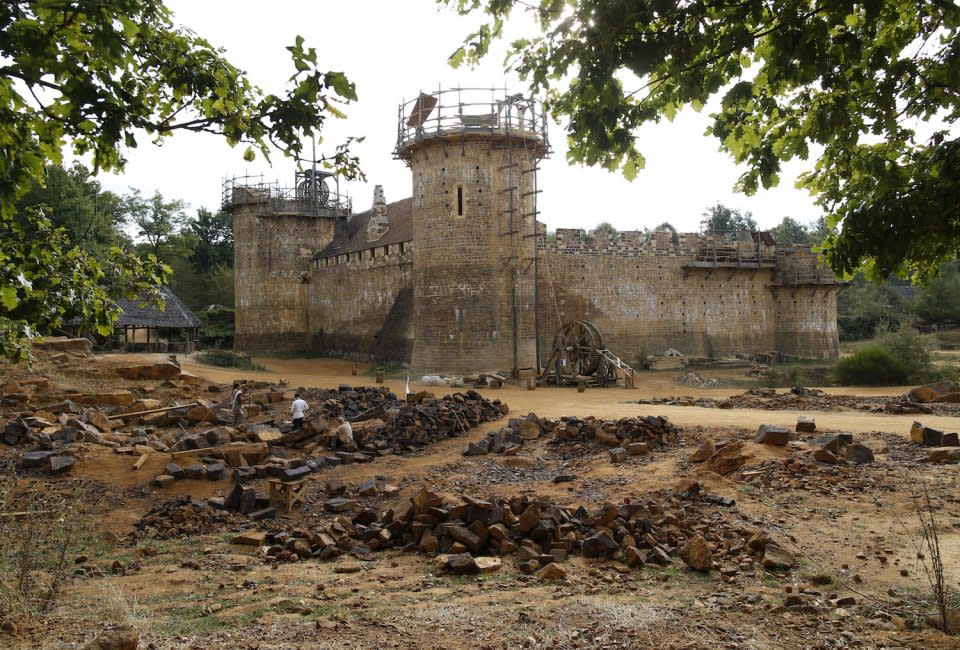A brand new ’13th-century castle’ in France has been under construction for 20 years — take a look inside

Jacky Naegelen/Reuters
When marveling at grand old buildings, it’s common to think, “They just don’t build them like this anymore.” But at a new castle in France, that saying does not apply.
In northwest Burgundy, two hours south of Paris, a castle is being built with the same materials, tools, and techniques that would have been used during the 13th century. The Guedelon Castle has been under construction for nearly 20 years, and serves as an immersive research and education project about medieval life and architecture.
Take a look.
The design of the castle is based on the architectural canons of the 12th and 13th centuries, which include high stone curtain walls and round flanking towers.

The venture was started by local chateau owner Michel Guyot and businesswoman Maryline Martin, who still orchestrates the project. 70 staff members currently work on the castle, with 35 directly involved in the construction. All the techniques they use — from how stone is cut to the makeup of the mortar — are modeled after 13th-century practices.

The construction site was opened to the public in 1998, and visitors are welcome to watch the building process in action. They’re even encouraged to walk around and talk to the workers. According to the Independent, the project was entirely funded by that tourism as of 2014.

Source: The Independent
To accurately imitate historical techniques, the construction team has consulted medieval financial records, looked at illustrations in illuminated manuscripts, and examined other castles that exist from the period. Here, Clement Guerard, a blacksmith at the site since 1999, poses in his workshop.

A scientific advisory committee, made up of historians, archaeologists and castellologists (yes, that’s a real field of study), consults on the project, which is considered the world’s biggest archaeological experiment. Below, tiler Bruno Feval is shown in his workshop.

To lift or lower heavy items, workers walk in a man-powered winch drum, which is used to coil or uncoil rope.

Work on the site began in 1997, when it was cleared for construction and the first workshops were built. Color was added to the walls in 2012, as can be seen in the castle bedroom.

The intricate timber work on the ceiling of the castle bedroom demonstrates the level of detail that has gone into the castle thus far.

To cut the stone blocks, “quarrymen” look for high-quality pieces. They find the best fracture line in the rock, and hammer a line of small holes along it. Then they place wedges into the holes and hit them with a sledgehammer to split the stone. The project’s overseer, called the master-mason, assigns them a list of sizes he needs.

The site for the castle was chosen based on its proximity to suitable construction materials, since 13th-century transportation would be difficult and time-consuming. The lot is located near an oak forest and a former quarry.

A fictional start date was assigned to the project to add to the historical accuracy: 1228. The castle even has an imaginary owner, Guilbert, a low-ranking lord who’s a vassal of Jean de Toucy, the actual ruler of the province at the time.

Those who want to do more than just visit the castle can also pitch in and work for a few days — approximately 650 people each year choose to do so. Here, women do traditional basket weaving.

The project is far from over — this year, masons are working on building a pigeon loft in the western corner tower and finishing the castle’s Chapel Tower with a parapet. The property now also includes a medieval hydraulic flour mill, where bakers grind the flour that’s used in bread baked in the castle’s oven.

The post A brand new ’13th-century castle’ in France has been under construction for 20 years — take a look inside appeared first on Business Insider.

 Yahoo Finance
Yahoo Finance 
